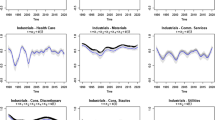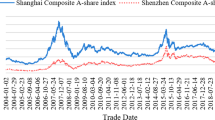Abstract
Many empirical works used risk modeling under the assumption of Gaussian distribution to investigate the market risk. The Gaussian assumption may not be appropriate for risk estimation techniques in some situations. In this study, we used the extreme value theory (EVT) to examine more precisely the tail distribution of market risk and incorporate high dimensional copulas to explore the dependence between stock markets. We gathered data of stock markets from Asean countries (Thailand, Singapore, Malaysia, Indonesia and the Philippines) to simulate the portfolio analysis during and post subprime crisis. The results found that D-vine copula GARCH-EVT model can simulate the efficient frontier of portfolios greater than other models. Furthermore, we also found the positive dependence for the overall markets.
Access this chapter
Tax calculation will be finalised at checkout
Purchases are for personal use only
Similar content being viewed by others
References
Aas, K., Czado, C., Frigessi, A., Bakken, H.: Pair-copula constructions of multiple dependence. Insur.: Math. Econ. 44(2), 182–198 (2009)
Allen, D.E., Singh, A.K., Powell, R.J.: EVT and tail-risk modelling: evidence from market indices and volatility series. North Am. J. Econ. Financ. 26, 355–369 (2013)
Artzner, P., Delbaen, F., Eber, J.M., Heath, D.: Coherent measures of risk. Math. Financ. 9, 203–228 (1999)
Ayusuk, A., Sriboonchitta, S.: Risk analysis in Asian emerging markets using canonical vine copula and extreme value theory. Special Issue on Copula Mathematics and Econometrics. Thai J. Math. 59–72 (2014)
Bali, T.G.: An extreme value approach to estimating volatility and value at risk. J. Bus. 76, 83–108 (2003)
Bollerslev, T.: Generalized autoregressive conditional heteroskedasticity. J. Econom. 31, 307–327 (1986)
Breymann, W., Dias, A., Embrechts, P.: Dependence structures for multivariate high-frequency data in finance. Quant. Financ. 3, 1–14 (2003)
Embrechts, P., McNeil, A.: Straumann, correlation and dependence properties in risk management: properties and pitfalls. In: Dempster, M. (ed.) Risk Management: Value at Risk and Beyond. Cambridge University Press, Cambridge (2002)
Embrechts, P., Resnick, S., Samorodnitsky, G.: Extreme value theory as a risk management tool. North Am. Actuar. J. 3, 30–41 (1999)
Engle, R.F.: Autoregressive conditional heteroskedasticty with estimates of the variance of U.K. inflation. Econometrica 50, 987–1008 (1982)
Furi, D., Climent, F.J.: Extreme value theory versus traditional GARCH approaches applied to financial data: a comparative evaluation. Quant. Financ. 13, 45–63 (2013)
Glosten, L.R., Jagannathan, R., Runkle, D.E.: On the relation between the expected value and the volatility of the nominal excess return on stock. J. Financ. 48, 1779–1801 (1993)
Hemche, O., Jawadi, F., Maliki, S.B., Cheffou, A.I.: On the study of contagion in the context of the subprime crisis: a dynamic conditional correlation multivariate GARCH approach. Econ. Model (2014). In press
Hernandez, J.A.: Are oil and gas stocks from the Australian market riskier than coal and uranium stocks? Dependence risk analysis and portfolio optimization. Energy Econ. 45, 528–536 (2014)
Horta, P., Lagoa, S., Martins, L.: The impact of the 2008 and 2010 financial crises on the Hurst exponents of international stock markets: implications for efficiency and contagion. Int. Rev. Financ. Anal. 35, 140–153 (2014)
Jess, R., Ortiz, E., Cabello, A.: Long run peso/dollar exchange rates and extreme value behavior: value at risk modeling. North Am. J. Econ. Financ. 24, 139–152 (2013)
Joe, H.: Families of m-variate distributions with given margins and \(m(m-1)/2\) bivariate dependence parameters. Distributions with Fixed Marginals and Related Topics. Institute of Mathematical Statistics, California (1996)
Karmakar, M.: Estimation of tail-related risk measures in the Indian stock market: an extreme value approach. Rev. Financ. Econ. 22, 7985 (2013)
Kole, E., Koedijk, E., Verbeek, M.: Selecting copulas for risk management. J. Bank. Financ. 31(8), 2405–2423 (2007)
Lee, Y.H., Tucker, A.L., Wang, D.K., Pao, H.T.: Global contagion of market sentiment during the US subprime crisis. Global Financ. J. 25, 1726 (2014)
Low, R.K.Y., Alcock, J., Faff, R., Brailsford, T.: Canonical vine copulas in the context of modern portfolio management: are they worth it? J. Bank. Financ. 37, 3085–3099 (2013)
Marimoutou, V., Raggad, B., Trabesi, A.: Extreme value theory and value at risk: application to oil market. Energy Econ. 31(4), 519–530 (2009)
Mashal, R., Zeevi, A.: Beyond correlation: extreme co-movements between financial assets. Unpublished, Columbia University (2002)
McNeil, A., Frey, R.: Estimation of tail-related risk measures for heteroscedastic financial time series: an extreme value approach. J. Empir. Financ. 7(3–4), 271–300 (2000)
Mensi, W., Hammoudeh, S., Reboredo, J.C., Nguyen, D.K.: Are Sharia stocks, gold and U.S. treasuries hedges and safe havens for the oil-based GCC markets?. Emerg. Mark. Rev. (2015). In press
Moralesa, L., Andreosso-OCallaghan, B.: The current global financial crisis: do Asian stock markets show contagion or interdependence effects? J. Asian Econ. 23, 616–626 (2012)
Naoui, K., Liouane, N., Brahim, S.: A dynamic conditional correlation analysis of financial contagion: the case of the subprime credit crisis. Int. J. Econ. Financ. 2(3), 85–96 (2010)
Patton, A.J.: Copula-based models for financial time series. In: Andersen, T.G., Davis, R.A., Kreiss, J.-P., Mikosch, T. (eds.) Handbook of Financial Time Series. Springer, New York (2009)
Ren, F., Giles, D.E.: Extreme value analysis of daily Canadian crude oil prices. Appl. Financ. Econ. 20(12), 941–954 (2010)
Rockafellar, R.T., Uryasev, S.: Optimization of conditional value-at-risk. J. Risk 2, 21–41 (2000)
Rockafellar, R.T., Uryasev, S.: Conditional value-at-risk for general loss distributions. J. Bank. Financ. 26, 1443–1471 (2002)
Sklar, A.: Fonctions de rpartition n dimensions et leurs marges. Publ. Inst. Statist. Univ. Paris 8, 229–231 (1959)
Wang, L.: Who moves East Asian stock markets? The role of the 2007–2009 global financial crisis. J. Int. Financ. Mark. Inst. Money 28, 182–203 (2014)
Wang, Z., Wu, W., Chen, C., Zhou, Y.: The exchange rate risk of Chinese yuan: using VaR and ES based on extreme value theory. J. Appl. Stat. 37, 265–282 (2010)
Wang, Z.R., Chen, Z.R., Jin, Z.R., Zhou, Z.R.: Estimating risk of foreign exchange portfolio: using VaR and CVaR based on GARCHEVT-Copula model. Phys. A 389, 4918–4928 (2010)
Acknowledgments
The authors are thankful to Dr. Supanika Leurcharusmee and Dr. Kittawit Autchariyapanitkul for reviewing the manuscript. First author was supported from Prince of Songkla University-Ph.D. Scholarship.
Author information
Authors and Affiliations
Corresponding author
Editor information
Editors and Affiliations
Rights and permissions
Copyright information
© 2016 Springer International Publishing Switzerland
About this chapter
Cite this chapter
Ayusuk, A., Sriboonchitta, S. (2016). Copula Based Volatility Models and Extreme Value Theory for Portfolio Simulation with an Application to Asian Stock Markets. In: Huynh, VN., Kreinovich, V., Sriboonchitta, S. (eds) Causal Inference in Econometrics. Studies in Computational Intelligence, vol 622. Springer, Cham. https://doi.org/10.1007/978-3-319-27284-9_17
Download citation
DOI: https://doi.org/10.1007/978-3-319-27284-9_17
Published:
Publisher Name: Springer, Cham
Print ISBN: 978-3-319-27283-2
Online ISBN: 978-3-319-27284-9
eBook Packages: EngineeringEngineering (R0)




